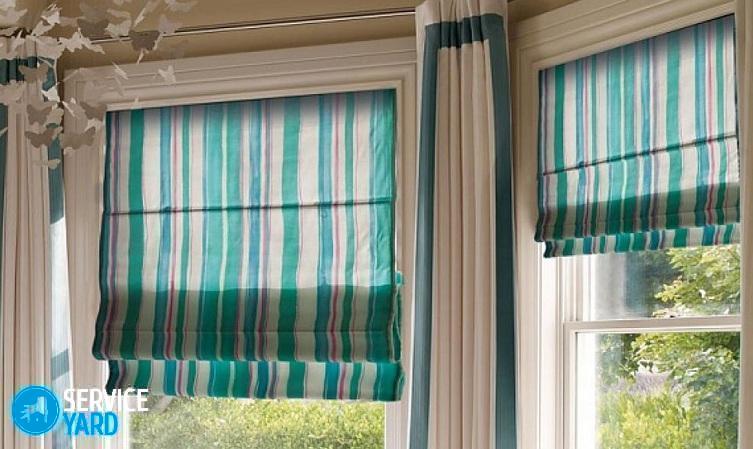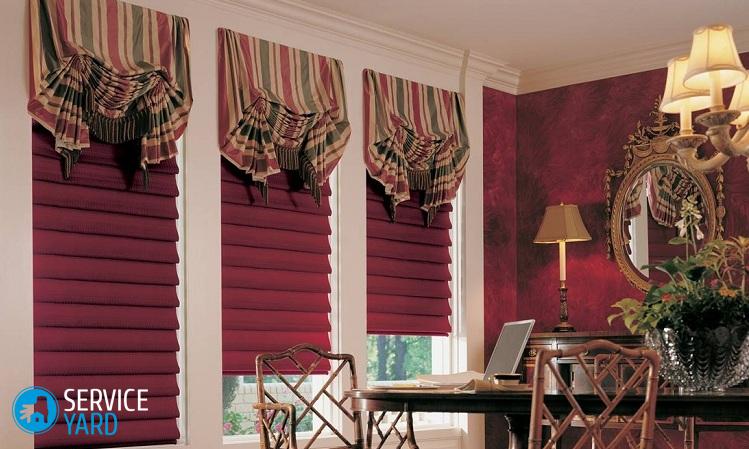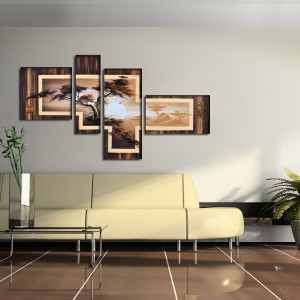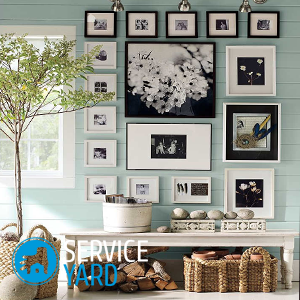DIY curtains from improvised materials
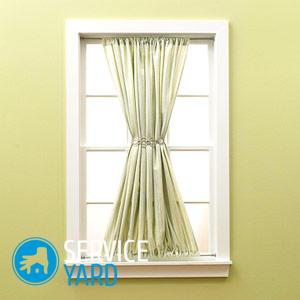
What are curtains for? It would seem that there may be questions - they were invented in order to protect the room from too bright sun rays and prying eyes. But the curtains also have other functions - for example, they separate rooms from each other, if you decide to refuse heavy doors, or designate certain zones. And it is not at all necessary to hang thick heavy curtains every time. You can, for example, make light curtains with your own hands from improvised materials. You will find some ideas in the article.
to contents ↑We are looking for materials
Everything you need to make decorative curtains with your own hands from improvised means can easily be found in your own home. Fit for you:
- beads;
- wallpaper;
- postcards;
- bottle caps;
- shreds;
- thick threads or ropes;
- old felt-tip pens and ballpoint pens;
- buttons
- shells;
- tapes.
All materials can conditionally be divided into several types, since the technology for making decorative curtains from improvised materials with their own hands will be the same:
- ropes, ribbons, shreds;
- buttons, beads, corks, shells;
- felt-tip pens, cocktail tubes and pens;
- paper and postcards.
Also, look for tools and additional materials:
- glue;
- double sided tape;
- fishing line or durable thread;
- scissors;
- paper clips;
- awl.
Paper curtains
Lightweight paper curtains will look good in the opening between the room and the corridor. Such a curtain can be used to separate the zone. You will need:
- postcards in large numbers - however, they can be replaced with colored paper or cardboard;
- ruler;
- pencil or pen;
- sharp scissors;
- fishing line;
- rail, the length of which is slightly larger than the width of the opening;
- rings on the screws;
- paper clips (preferably plastic, multi-colored).
The process of creating curtains with your own hands from improvised materials in itself takes no more than an hour:
- Cut postcards or paper into strips of 3-5 cm in length and a width equal to the width of the paper clip multiplied by 4.
- Fold the paper elements in half along.
- Insert long edges inwards.
- Smooth the folds.
- Pinch the strip with a paper clip.
- Make as many paper elements as you need, and pinch everything with paper clips.
- Connect all the elements in long stripes.
- Saw the curtain rod from the rail.
- Grind it and cover it with paper or cloth.
- Mark the ledge and screw the rings.
- Fasten paper strips into rings.
- Make the bottom edge.
How to be the edge?
Variations in the design of curtains from improvised materials with their own hands - a lot. It’s quite difficult to make the straight bottom of paper curtains, and it will not look very impressive. Therefore, you can choose one of the following options:
- arch;
- zigzag;
- wave;
- arbitrary alternation of long and short stripes;
- asymmetry.
to contents ↑Important! There is another option - you can decorate the ends of all ribbons. For example, cardboard flowers or geometric shapes.
Tubules are wealth!
A simple and original way to quickly create curtains with your own hands from improvised means is to use the tubes that are at hand.
Important! It’s not necessary to run to buy expensive bamboo. You can get by with the fact that there is in the nearest hypermarket or pharmacy - several sets of tubes for cocktails are quite enough, tubes from droppers will also work, but you can do it even easier.
If your child plagues markers in dozens - do not rush to throw away those that are no longer written. Put them in a separate box where they will wait in the wings. For example, the moment when it will be necessary to make a curtain.
You don’t need to specially prepare the tubes for cocktails, but the remnants of felt-tip pens will have to be put in order first, so that it is convenient to make curtains with your own hands from such improvised materials. However, this is not difficult:
- Remove from the cylinders everything that remains there.
- Wash them so that there are no noticeable spots.
- Dry it.
- Cut off the noses, if any - the cylinders should be even.
It is necessary to think in advance how to make sure that the cylinders do not slip off the threads. This can be achieved in two ways:
- tie large knots at the bottom;
- to attach at the ends something flat, but of a larger diameter - for example, buttons, balls, beads, corks or circles made of thick cardboard.
Important! The first option is more suitable for cocktail tubes - they have small cavities, and if the threads are thick enough, it is easy to tie a large knot. The second option is good for felt-tip pens and pens.
Cornice
Even such a simple curtain made of improvised materials should hold on to something. There are several ways to do this:
- make a cornice from a lath or bar;
- stuff carnations (for example, on a door jamb);
- hang the curtain on a fishing line or a strong thread.
Make the curtain
The manufacturing process of the curtain itself from such improvised materials is extremely simple. The main thing is that the tubes are of the same diameter, then there will be no need to make jumpers between them:
- We measure the length of the future curtains.
- Cut the threads a little longer - you need a margin for attaching to the cornice and fixing the bottom.
- We thread the needle (any, most importantly, so that the eye is large).
- We string the tubes, leaving the free ends of the threads at the top and bottom.
- We fix the lower parts.
- We tie the finished elements to the fishing line stretched at the top or fix them in rings on a wooden cornice.
Tubules and buttons
Buttons or large beads can be placed between the tubes. Buttons should be chosen without legs, with two or four holes. We string, alternating elements. This option is especially good if you have tubes of different diameters. If you do not place additional elements between them, thick tubes will be put on thin ones.
The manufacturing procedure will be the same as for the manufacture of curtains from felt-tip pens, only at the bottom of each suspension should be a button - and in this case, the one with the leg will do.
to contents ↑Important! To string translucent tubes for cocktails, you can take colored synthetic twine or multi-colored cotton threads (for example, iris) - this will give your product a special charm.
Old beads and new threads
Have you ever strung berries? Almost everyone did this in childhood, so making a curtain from improvised materials such as beads would not be difficult even for a very inexperienced needlewoman. This is even easier than stringing rowan or hawthorn, because there are already holes. The most important thing is to pick up a bead.
Something you can buy in the store for sewing. But that jewelry is also suitable that has already gone out of fashion or broken in some places.
to contents ↑Important! It is not necessary that all beads be the same color, shape and size, you can come up with interesting compositions from different ones, alternating them in a certain order or even using random combinations. The ends of such decorative curtains from improvised materials can be fixed in knots or tied to an extreme bead as is usually done when weaving from beads.
Curtains for hi-tech lovers
Do you want your apartment to look extravagant? Nothing is impossible. You can make very original metal curtains - for example, from washers. Only they need to be strung on metal, too, the fishing line for such a design is not strong enough. So you need:
- washers, nuts or other metal rings;
- wire, which can be given any shape;
- metal rod for cornice;
- scissors for metal.
As in any other case, start the work with measurements - you need the length of each element and the cornice.Why, it is better to take a metal bar - solely because the curtains are quite heavy. But there will be no problems with securing the ends and suspending, the wire is elementarily screwed to both nuts and to the cornice:
- Cut the wire taking into account the stocks for the design of the edge and for screwing to the cornice.
- Attach the bottom washer so that it does not fall off - just thread the wire into it several times and tighten.
- String the rest of the nuts - this can be done in two ways, that is, in the same way as beads, or by fixing each with one turn of wire around the rim.
- When the element is ready, screw it with the same wire to the ledge.
to contents ↑Important! The main advantage of such curtains is the ability to get materials for free.
Cork curtains
Cork is a noble and beautiful material. True, it has one drawback - it is quite problematic to collect a sufficient number of corks, which mainly plug wine bottles. But you can worry about this in advance by asking friends not to throw out such valuable material after the feasts. In addition to the actual traffic jams, for the manufacture of decorative curtains with your own hands you need:
- strong cotton threads;
- cornice - wooden or from fishing line;
- awl;
- needle.
The process is not much different from stringing berries, which we have already mentioned. True, it is better to worry in advance about how exactly you will arrange the traffic jams:
- along;
- across.
In the first case, each element is pierced through from the side of the flat parts - the material is soft enough, so if your needle is long enough and thick, an awl is not necessary. In the second case, the plugs are strung across - try only so that each puncture is approximately in the middle.
to contents ↑Important! Instead of natural corks, you can also use plastic ones - only you have to tinker with punctures, in this case you can’t do without an awl, but it’s better to take a drill in general.
Pleated Curtains
Remained from the repair of the wallpaper, which you do not know where to put it? Do not rush to throw it away, they will still be useful to you. You can even make a decorative curtain for a window or door from them, not to mention the fact that you can’t think of anything better for zoning a room - they will separate the zone and not get out of style.
Prepare the following items for your curtains from improvised materials with your own hands:
- wallpaper residues;
- cardboard;
- kapron threads;
- awl;
- scissors;
- ruler;
- double sided tape;
- clothespins (you can take small colored ones), or clamps.
Making a blank
It all starts with measurements, and the manufacture of pleated curtains is no exception. You need to measure the length and width of each leaf - most often such curtains are hung on the windows in small apartments. They are simply irreplaceable, since they are hung directly on a frame or glass, without cluttering up the windowsill and without taking precious centimeters in the room itself, as happens with heavy curtains.
When measuring, you need to consider some considerations:
- 1 cm should be subtracted from the width of the opening to get gaps - your future curtains should not touch the frames.
- Width is measured to where the handle is, if any.
- To find out the dimensions of the panel, you need to multiply the estimated length by 1.5.
Next begins the actual production. Why it is recommended to take wallpapers - so because they are much easier to cut than any other paper:
- Cut the strip to the desired length.
- Lay it on the table or floor with the wrong side up.
- Mark the edges every 2-4 cm.
- Connect them with straight lines - make sure that these lines are strictly perpendicular to the edges.
- Duplicate the marking with the end of the scissors along a long ruler - it will be easier to fold.
Important! The folds should not be too wide, otherwise the curtain will turn out to be very massive.
Accordion pleats
Pleating on paper is much easier than on fabric.You just need to fold the workpiece with an accordion along the already outlined lines and properly smooth the bends. By the way, no one bothers to use an iron for this purpose, although, of course, it is not necessary to heat it.
Important! So that the folds do not part, the ends of the resulting corrugated strip are clamped with paper clips or clothespins. Another fixation point is in the middle.
Making elements
The curtain is ready, but the question arises, how can I hang it, like this? Just this, without any holes - nothing:
- Find the middle of the long side.
- Draw a perpendicular to this point.
- Divide the perpendicular in half and put a point.
- Make a puncture at this point - here it was awl and useful.
- Cut a piece of cord - it should be 10 cm more than the height of the sash.
- Tie a button to one end of it.
- Thread the cord through the hole.
- At the bottom, place a latch (for example, from an obsolete sports jacket.
Important! You can, of course, use any other lock, but the one that is from sportswear is more convenient - with its help you can slide and open the curtains.
Making the bottom edge
The appearance of your curtain largely depends on how the bottom edge is framed. It can be straight or rounded. Rounding is called swag by professionals. To make it, you just need to thread the lace through the middle and hang the curtain. The edge will bloom itself in a beautiful semicircle.
Straight bottom
Oddly enough, making a straight edge is harder than a rounded one. To do this, do the following:
- To retreat from the side edges of 5-8 cm.
- Make holes.
- Thread 2 cords through them.
- Thread another cord in the middle.
We hang the curtain
It is best to hang a light paper curtain on a paper cornice - it is quite light:
- Cut 2 cardboard strips.
- Glue one of them to the place of the cornice.
- Glue the second strip from the bottom between the folds.
- Hang the curtain with double-sided tape to the ledge.
- Decorate the bottom as you like - beads, lace, braid, etc.
Stock footage
In short, for the manufacture of curtains it is not at all necessary to buy expensive curtain fabrics. Without spending a dime, you can do something spectacular and original, especially since things made by your own hands from improvised materials are now in great fashion and very much appreciated.



